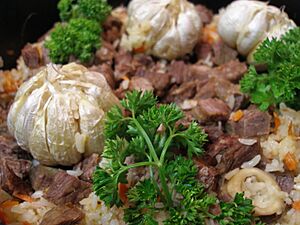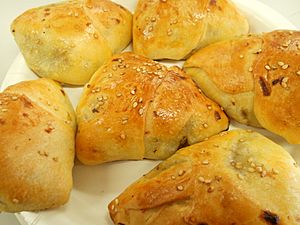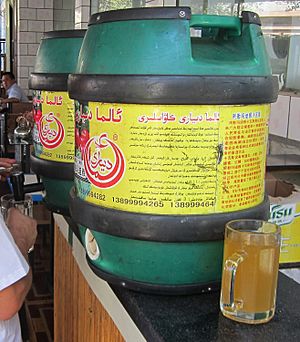Uyghur cuisine facts for kids

Uyghur cuisine is the delicious food of the Uyghur people. You can find it not only in their home region of Xinjiang but also in many other places. Some of the most famous ingredients are roasted lamb, tasty kebabs, and rice. Since many Uyghur people are Muslims, most of their food is halal, meaning it follows special rules for how it's prepared.
You can find Xinjiang restaurants all over China. This is because many people from the region move to other areas and open their own food places. Big restaurant chains like Herembagh and Yershari serve Uyghur dishes.
Contents
What Makes Uyghur Food Special?
The Uyghur people make up a large part of the population in Xinjiang (which is also known as Uyghuristan or East Turkistan). So, it's no surprise that their food is very important there! Uyghur food often uses mutton (lamb), beef, chicken, and goose. They also use lots of fresh vegetables like carrots, tomatoes, onions, peppers, eggplant, and celery.
For breakfast, Uyghurs often enjoy tea with homemade bread, a creamy dairy product called smetana, olives, honey, raisins, and almonds. When guests visit, Uyghurs love to offer them tea, flatbread called nan, and fruit before the main meal is ready.
Popular Uyghur Dishes

Many Uyghur dishes are also eaten by other groups in Central Asia. Uyghur food also shows some influence from Han Chinese cooking. For example, the Han people brought many new vegetables to Xinjiang, like cucumbers and eggplants.
At big events like weddings, Uyghurs in cities often serve food made with Chinese cooking styles, like so säy (stir-fries). Meals often start with liang säy (cold dishes) and issiq säy (hot dishes), served family style for everyone to share.
Noodle Dishes
A very common Uyghur dish is laghman or leghmen. These are special handmade noodles. They are made from flour, water, and salt. The dough is rolled into small balls, then stretched by hand into long noodles. The noodles are boiled until they are soft. Then, they are topped with stir-fried meat and vegetables. These vegetables often include bell peppers, chili peppers, cabbage, onions, and tomatoes, all cooked in a rich meat broth.
Rice Dishes
Another classic Uyghur dish is polu. This is Xinjiang's version of Pilaf, a rice dish popular across Central Asia. In a common polu recipe, carrots and lamb (or chicken) are first fried in oil with onions. Then, rice and water are added, and the whole dish is steamed until cooked perfectly. Sometimes, raisins and dried apricots are added for a sweet touch.
Breads and Baked Goods

A common bread in Central Asia is nan, a baked flatbread. It's made with sesame seeds, butter, milk, vegetable oil, salt, and sugar. Girde is another popular bread, shaped like a bagel with a hard, crispy crust.
Sangza are crispy, fried wheat flour twists. They are often a special treat for holidays. Samsa are lamb pies baked in a special brick oven. Yutaza is a steamed bread with many layers. Göshnan are lamb pies cooked on a pan. Pamirdin are baked pies filled with lamb, carrots, and onions. Shorpa is a warm lamb soup. Other breads include Toghach (another type of tandoor bread) and Tunurkawab.
Meat Dishes
Besides the dishes mentioned, you'll find soups made from lamb or chicken. Kawaplar (kebabs) are very popular. They are made from lamb or beef and seasoned with chili powder, salt, black pepper, and cumin. People eat kebabs by holding the skewer parallel to their mouth and sliding the meat off with their teeth.
A well-known dish in Xinjiang, though not originally Uyghur, is dapanji (which means "big plate chicken"). It's a spicy chicken stew served on a large plate. After the chicken is eaten, wide, flat, hand-pulled noodles are added to soak up the delicious sauce. This dish became popular in the 1990s. It's said a person from Sichuan created it in Shawan, northern Xinjiang, by adding hot chili peppers to chicken and potatoes to make a Sichuan-style flavor.
Spices and Flavors
Uyghur food uses spices like cumin seeds, red pepper flakes, salt, and black pepper. Raisins and meat fat are also used to add flavor to many dishes.
Drinks
Common drinks include Uyghur black tea and milk tea. Another popular drink is a local black beer from Xinjiang. It's known for having a stronger flavor than other Chinese beers and is sold all over China.
Grapes grow well in the Xinjiang region. They are used to make wine and other grape products. In Turpan, wine is a big part of the local economy. It was even famous back in the Tang dynasty! The local wine, called museles, is made and enjoyed by many people. It's also sold to other regions.
Desserts
Uyghur nut cake is a sweet treat. While it's different from Middle Eastern phyllo dough baklava, it shares a similar name. This delicious cake is made with dates, raisins, walnuts, and syrup.


